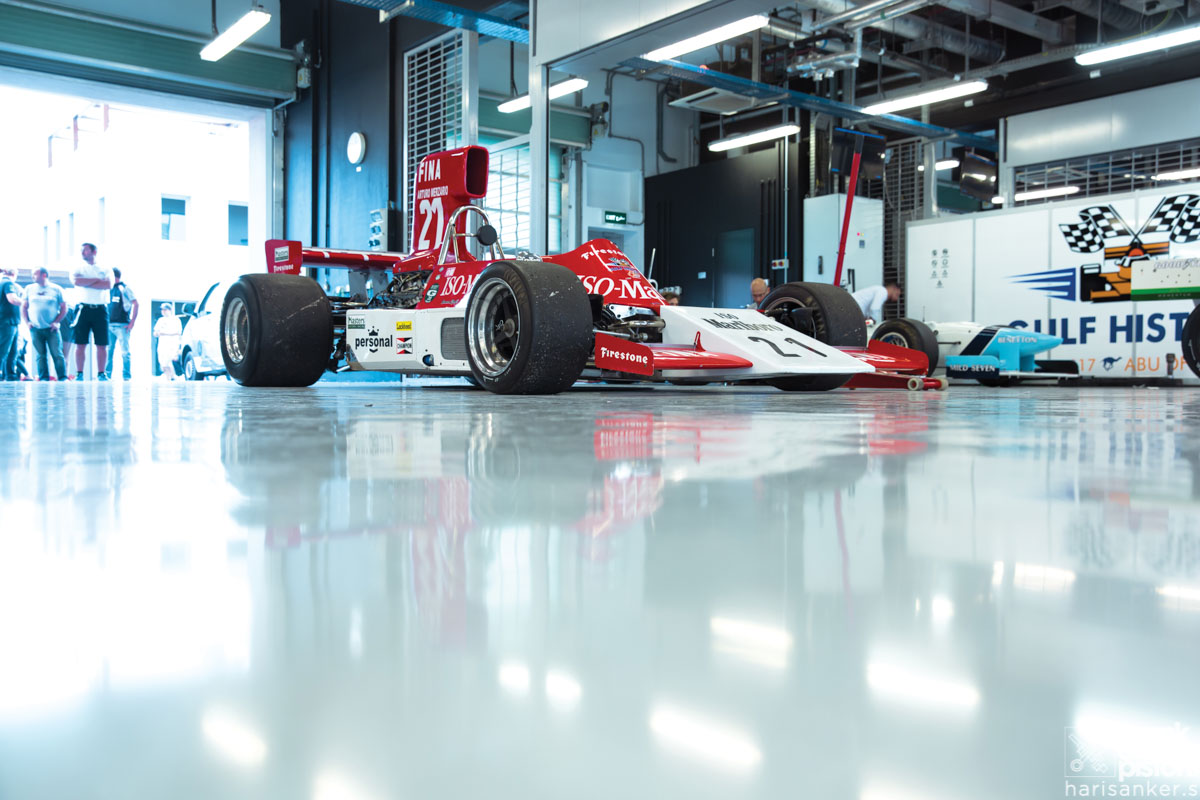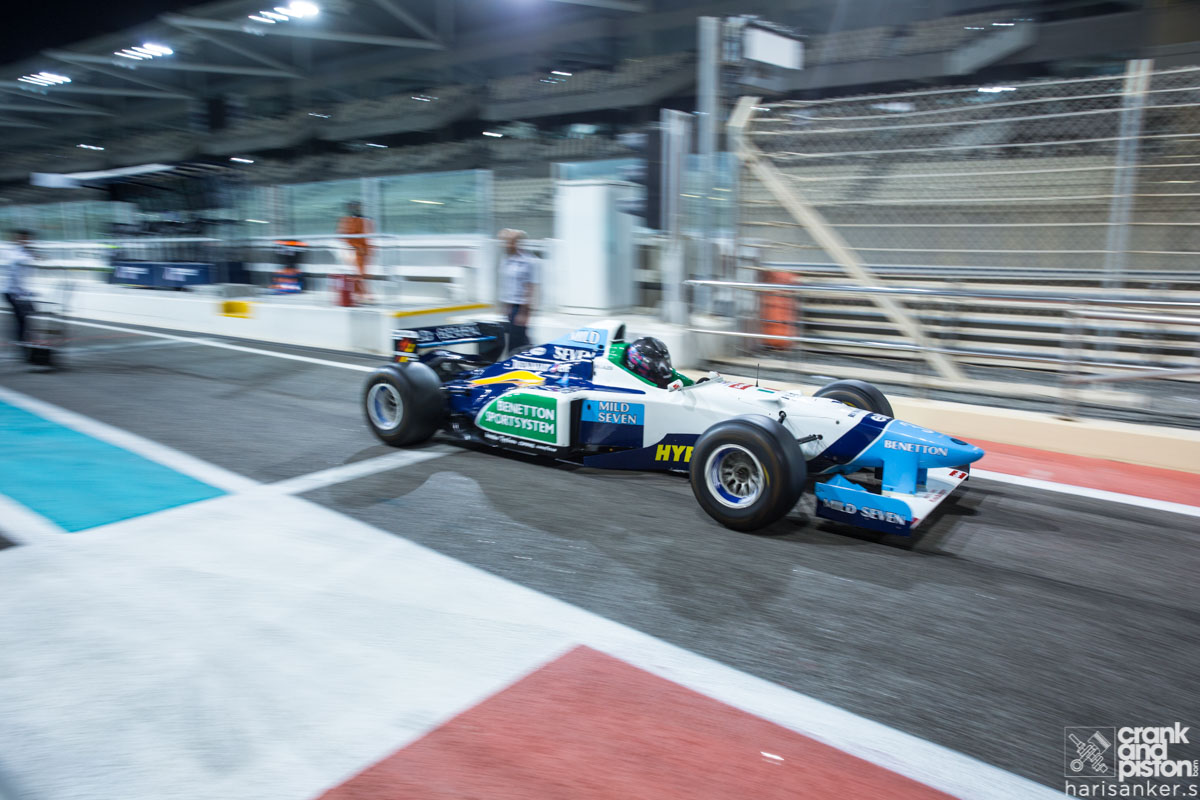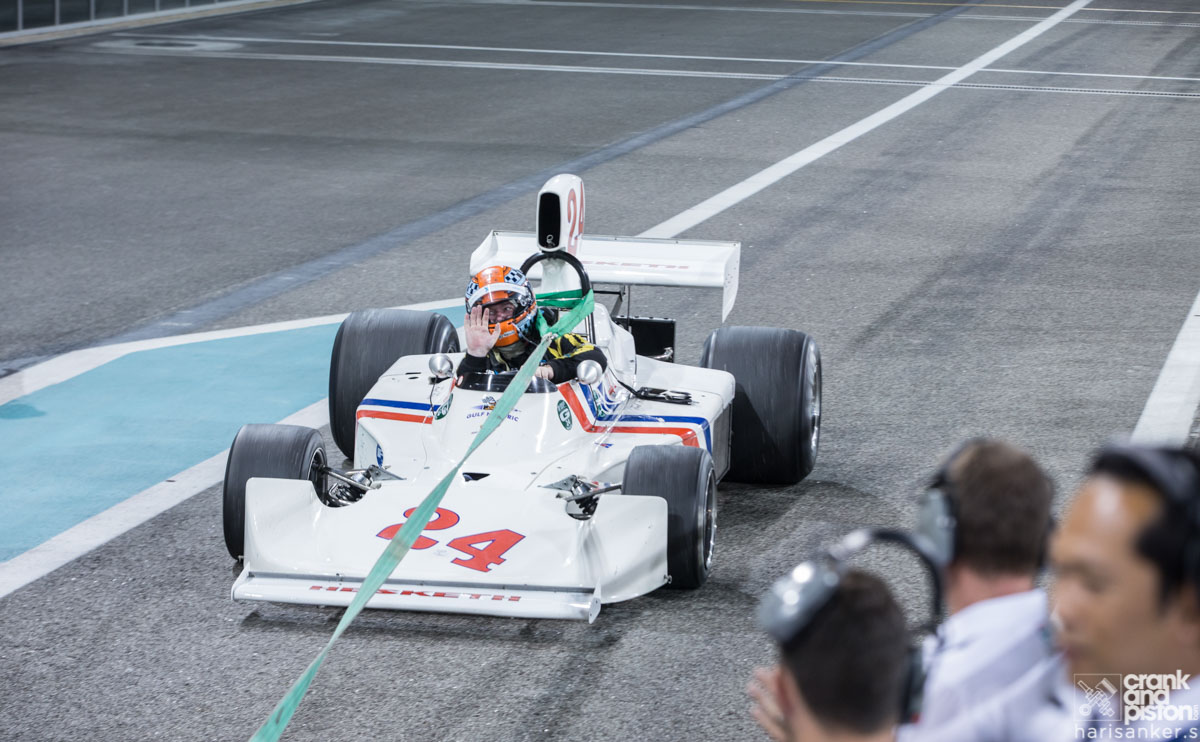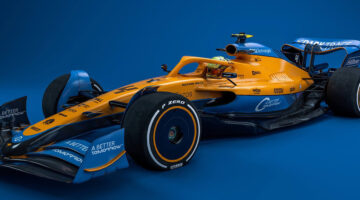Old racers never die, they just end up in private collections and are rarely seen in the outside world. Gulf Historic is set to change that and offered c&p’s editor the drive of his life
It’s not often one gets to realise a dream but, on the day before the Gulf 12 Hour endurance race weekend, I’ve just walked into garage number 23 at Yas Marina Circuit knowing I’m about to do just that. In front of me is a garage full of stunning historic Formula 1 cars and one of them has my name on it. Literally.
While most of you will be familiar with the Gulf 12hr race, as its been running for several years now, you probably haven’t heard of the Gulf Historic race, as this is its first iteration. On this occasion it’s being run in support of the main race, as an exhibition event to test the region’s appetite for historic racing. The brain-child of Dubai-based GP Xtreme, who you may be familiar with for their awesome Sheikh Zayed Road showroom in Dubai, that sells some of the coolest racing memorabilia and merchandise, not to mention houses a state-of-the-art racing simulator. What you might not know is that they also organise F1 driving experiences, run a fully fledged GT race team (I raced for them in last year’s Creventic 24HR series and hope to do so again this year), and with the most significance to the weekend ahead of me, they own and operate a fleet of historic Formula 1 cars that are regularly raced in classic events around the world, such as the Monaco Historic Grand Prix.
It’s hard to put into words just how captivating this array of very special racing cars is, as it’s quite surreal to be surrounded by so much history in one place. Inevitably the first car I’m drawn to is the 1974 Hesketh 308B, resplendent in its white livery unsullied by any vulgar sponsor logos, as was the ethos of team boss Lord Hesketh. This was the car that launched the legendary career of James Hunt and was more recently immortalised in the movie Rush. It’s hard to stay focused on a single car though, as to the left of the Hesketh are two identical and very gorgeous Warsteiner gold-liveried Arrows A3s that were successfully raced by Jochen Mass and Ricardo Patrese in 1980 and ’81. Next to the two Arrows is perhaps the prettiest of the cars assembled – not to mention the oldest – a powder blue 1971 Matra campaigned by Chris Amon. In 1974 the Kiwi driver would set up his own eponymous team, and the lone car produced by Amon F1– the AF 101– is also in attendance today. Another driver who set up his own team was John Surtees, the only man to win world championships on two wheels and four, competing in his self-titled Surtees TS19 in 1976. Probably best known for being controversially sponsored by Durex to the delight of sniggering teenage boys everywhere, the condom makers branding still adorns the model that’s here today.

If you’re a racing fan you’ll be very familiar with the Saudia sponsored March 761B, most famous for being the car that started the story of Williams F1 as we know it today. It was purchased in 1977 as a customer car from March F1 by Frank Williams, and developed by a young engineer by the name of Patrick Head. That’s not the only car here with a Williams link though, as last but not least is the car I’ll be piloting this weekend: a 1974 Williams FW03. As the name would suggest this is the third car produced by Frank Williams Racing Cars, prior to the team going bankrupt. A few years later Sir Frank would ‘rise from the ashes’ to set up Williams F1 and, multiple world championships later, the rest is history.
Before I can fulfil my dream of driving this piece of Formula 1 folklore, I need to find out if I can physically fit in it. F1 cars are notoriously tightly packaged and I’m not exactly the smallest guy in the world, so I’m pretty anxious as I wait for my race-engineer Simon to finish with his preparations before I gingerly step over the side of the chassis. I’m now standing on the bare metal floor of the car, placing an arm on each side of the body. I slowly lower myself down and my legs forward in much the same way you would get into a bathtub. To my relief there is a lot more space than I expected, although the seating position is startlingly upright with my legs pretty much at a 90-degree angle from my body. Click the detachable steering wheel back into place and my arms are fully outstretched in front of me, which isn’t exactly the ideal driving position but is typical of the era and, thankfully, means I will definitely be driving it the next day.
As I’m sat on the bare metal tub of the car, the next step is for Simon to craft a makeshift seat for me, which is done using the highly scientific process of putting a piece of foam sheet behind my back and cutting it to the shape of my body with a pen-knife. Apply some masking tape to give it some rigidity and, voila, you have a vintage Formula 1 seat. While this process is ongoing, I have plenty of time to absorb the details of my surroundings and the first thing that strikes me is the simplicity of everything. The small suede steering wheel is completely devoid of buttons, and the only things on the dash are three analogue dials (the central rev counter is upside down so the wheel doesn’t obstruct it), a couple of toggles and the starter button. Just to the right of my arm is a tiny lever that operates the H-pattern 4-speed ’box, and you can even rest your right arm on the exposed gear linkage.

I’m reminded that I’m sitting in a piece of F1 history as, to my left, on the inside of the tub, is the FW03’s former driver Arturo Mezario’s signature, which includes a doodle of his famous cowboy hat. Apparently he wrestled this very car to a best finish of fourth at Monza – quite a feat for such a young team. As the car is still being prepared, it’s up on stands with no wheels and most of the bodywork is missing, so you can pretty much see every detail of the tube-frame chassis. The best way to describe the frame is that it’s not dissimilar to an oversized go-kart, in other words it’s shockingly flimsy. Best not to think about that then, particularly as I’ve come across a slight problem: my feet are too big for the footwell. I guess Sir Frank wasn’t considering my size 46s during the design of this car, but it’s a legitimate problem for me as there isn’t enough vertical space at the front of the chassis. Moving my foot from the accelerator to the brake isn’t possible without snagging my toes on the chassis, so Simon suggests I wear “smaller shoes” tomorrow…
Needless to stay, tomorrow can’t come soon enough and after tossing and turning for a few hours I give up hope of getting any meaningful sleep. I usually snooze my alarm multiple times before I coax myself into getting my day started, but today is different. I jump out of bed knowing that I will be driving a Formula 1 car. I walk into the garage a few hours before our first practice session is scheduled, and see the car fully assembled for the first time. All the bodywork is now in place, the iconic red and white Marlboro livery a reminder of a bygone era when tobacco advertising was the norm. Now that the wheels are on, the first thing that you notice is the comical difference in the size of the small front tyres and the massive rear Avons. The high air box and long rear wing complete the Wacky Racers dimensions, and the look is so much more charismatic than anything from the modern era.
Strapped in so I tight I can barely breathe, my heart is beating so hard it feels like it’s about to burst through my chest plate. I’m waiting for Simon to give me the signal when the pit lane light goes green and, sure enough, moments later he makes a circular motion with his skywards pointed index finger that is the international sign for “fire her up”. I flick down the toggle switches for the ignition and fuel pump, then finger the discreet looking starter button and the legendary Cosworth DFV erupts behind me in a cacophony of noise and vibration. I rest my foot on the throttle, as I’ve been told I have to keep the revs up to stop it from switching off. I push down on the relatively light clutch and snick the deliciously short gear lever into its dogleg first gear. I up the revs a little bit and release the surprisingly progressive clutch, hang a right out of the pit garage and the next thing I know I’m trundling my way down the pit lane.
It feels like the entire grid of drivers and mechanics from the main Gulf 12Hr race is out in the pit lane with camera phones at the ready. In a paddock full of the latest and greatest in modern GT and Prototype machinery, the historic cars are undoubtedly the stars of the show. As I exit the pit lane tunnel and join the track, I’m extremely cautious as I have no idea what to expect, having not driven many vintage cars, let alone an F1 car from 1974. I gingerly squeeze the throttle expecting violent wheel spin, but the massive rear tyres don’t protest. This encourages me to get more adventurous and the urgency with which this four-decade-old-car picks up and goes is startling. I wouldn’t say it’s shocking, but it’s certainly much more accelerative than, say, a current GT3 car.
Even though I can up-shift without pressing the clutch, I choose not to do so in the initial stages, to avoid any mishaps. The gearbox requires a very firm and precise hand, but no more than a flick of the wrist as the movement is so short. The unassisted steering is really heavy, but as I start to gather confidence and pick up speed it starts to lighten up. As you’d expect you can feel everything that’s going on at the front of the car, a sensation that’s exaggerated by being able to see the front wheels move as I turn the wheel.
As I gain confidence and the tyres start to warm, I start to use all of the throttle pedal, and on Yas’s endlessly long straight the sensation of speed is amplified by the feeling that you are seriously exposed, with almost no safety elements for protection. As I hurtle towards the first chicane it’s hard to ignore that the car I’m piloting is from an era in which a quarter of the drivers on the grid didn’t make it to the end of the season. As I approach the braking zone, I come off the gas about 50 metres too early, and while I’d like to regale you with tales of late braking heroics, the truth is I never feel confident enough due to the difficulty I’m facing moving my oversized feet. Despite having painfully contorted my toes to fit into race boots that are three sizes too small, I’m still struggling for space. The last thing you want is to not be able to find the brake pedal while nudging 280kph, with only a fibreglass nose protecting your legs. Other than my timidity in the big braking zones though, I continue to up my pace and, as I do so, the Williams starts to feel like a big, massively powerful go-kart, such is the lightness with which it changes direction. There’s also plenty of traction out of the tighter corners and it’s surprising just how early you should commit to the throttle, such is the mechanical grip it possesses.
And then, just as I start to get the hang of things, the engine goes bang. The glorious sound of the V8 is suddenly replaced by silence, as I roll to a stop on the side of the track. Gutted, I climb out of the car rueing the fact that, ‘just like that’, my time in this very special car has prematurely come to an end.

It doesn’t take long for my frown to turn upside down, though, as my weekend gets even more surreal when, over dinner, GP Xtreme team boss, Fred, casually mentions that I will be driving one of the two Benetton B196s that are parked at the back of the garage. I had been under the impression that they were there for display purposes only. Jean Alesi and Gerhard Berger raced them during the 1996 season, making them too modern to be considered historic, but the team is planning to run them tomorrow “to make some noise” and add to the spectacle. Holy crap, things just got really serious!
So, as not to interfere with the proper historic cars, the two Benettons will be starting the race from the pit lane rather than the main grid. Thankfully there’s more room for my feet in this one, but that does very little to quell the storm of butterflies that’s rampaging around my stomach. My new race engineer, Pascale, walks to the back of the car, places the external starter in its rear and suddenly the V10 erupts with a harsh violence that jolts through my entire body. Before I’ve got a chance to absorb what’s going on, the pit lane light turns green and I’m waved out onto the track. I dip the tiny hair-trigger clutch, pull the right paddle shifter, raise the revs to about 5000rpm and bunny hop my way off the line, barely avoiding an embarrassing stall. The security of being in a virtually indestructible carbon monocoque means – unlike the Williams – safety is not on my mind, and after a couple of laps to get some heat into the tyres and brakes, I start to drive the Benetton like I mean it.
It’s hard to put the violence of the acceleration into words; it’s everything I imagined it would be and much, much more. The force with which I’m pinned back into my seat is hard to comprehend and, without realising it, I break out into maniacal laughter, such is the ridiculousness of the sensation produced by the combination of 800bhp and 600kg. If someone were to hear the noises coming from underneath my helmet they would think I was mad. Not that anyone would be able to hear me though, as the glorious V10 shriek emitting from behind my head is so loud it hurts my ears, despite the fact I’m wearing earplugs. My ears aren’t the only thing taking a beating though, as my neck is pounded into submission every time I hit the carbon brakes. The retardation is so immense it’s hard to keep my head from dipping, yet I’m sure I’m barely scratching the surface of the abilities of this incredible car. Through the corners I throw the car in at speeds my brain is telling me aren’t possible, yet it shrugs off my best efforts and remains nothing but planted. You can actually feel the downforce sucking the car to the ground – the physical effort needed to drive this relatively modern F1 car is shocking, and while I am disappointed when I see a pit-board signifying the end of my run, I’m not sure if my neck could have handled many more laps.

With my time in these truly remarkable cars coming to an end, it’s striking how incredibly large the gap in performance and safety is after two decades of Formula 1 development. Both eras are extremely special in their own way, but the older cars have a charm and character of their own that you can’t help but gravitate towards. It’s particularly special to see these pieces of Formula 1 history being driven in the contrasting, futuristic setting of the Yas Marina Circuit. I leave with an even bigger respect for the immense bravery of F1 drivers of the 1970s, racing these cars at places like Spa and the old Nurburgring. Meanwhile driving the Benetton gave me a new found perspective of the sheer violence experienced when racing a modern Formula 1 car.
The first edition of the Gulf Historic race has been a truly special event that will only grow bigger and better in the years to come. For me though, I’ll always remember it as the time I got to realise a dream – not once, but twice.



